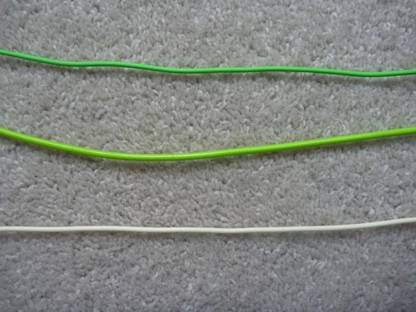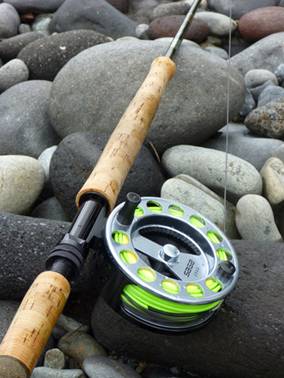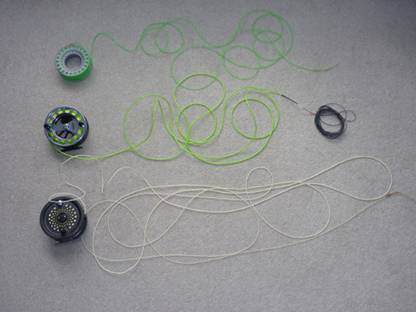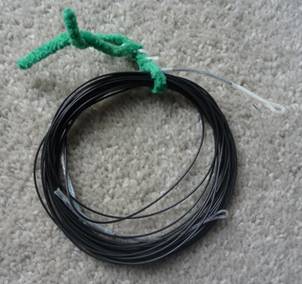GETTING STARTED WITH 2 HANDED FISHING GEAR
Rods
The world of 2 handed casting and fishing can be very confusing to a newcomer, even one that has a background in single hand fly fishing. I am by no means an expert but I have made a start and wanted to offer some advice on setting up for two handed fishing. I will not go into the different casts and how to do them as I do not believe it is a subject that lends itself to the printed word. Get some lessons or at least get a good Spey casting DVD like the Rio modern spey casting set.
Firstly there is the choice between Spey rods and Switch rods, generally spey rods start at about 12 ft long and go up to 17 ft. Switch rods can be anything between 10 ft and 12 ft but mostly are 10 feet six inches or 11 feet six inches long.
Spey Rods
The full spey rod is a specialist tool and in the heavier weights is meant for big water and big fish. But spey rods are now coming on the market in much lighter weights like #4/5 rods in about 12 ft or slightly longer. These are sometimes referred to as trout spey rods.

Line Thickness
The first thing to consider when thinking about buying a spey rod is that the majority of spey rods are about 2 weights heavier than a single hand rod, so a 12 ft #4/5 is more like a #6/7 in the line weight it is designed to cast. Just to make it a little bit more confusing there are one or two rod makers who do label their rods in the single hand line weight! So you need to check with the makers to find out what range of grain weight suits that rod. Rio has a great table of grain windows for many makes of rods on their web site. Mostly if using a Spey rod and a full traditional line the matching is easy, if you have a #8 Spey rod a #8 Full Spey line will match it.
Every Spey rod will have a Grain window that the rod is designed to work with and the window may be as big as 100 grains, say 350 to 450 grains. This is to allow for the different types of lines the rod may cast. If casting a traditional line you may have a head of 70 ft in a D loop behind the rod on the forward stroke. With a Scandi head this may only be 32 ft so the Scandi head will be at the lighter end of the rods grain window, the traditional line may be somewhere in the middle and the heavier Skagit line at the top end. The Skagit line will be heavier even though it is shorter as they are so dense and all the weight is in the head.
Switch Rods

Switch Rod Skagit Line
Most of the above also applies to Switch rods but again some makers will label a rod a #6 and mean a #6 Spey (#8 single) and some will label a rod a #6 and mean a #6 single hand.
Switch rods are shorter than a spey rod because they are designed to be a little bit more versatile in that they can be cast overhead style similar to a single hand rod, or overhead two handed style, or spey style casts. This makes them suited to many styles of fishing including long distance casting of the beach with a shooting head, swinging a big fly downstream on medium to big rivers even with no back cast room and Nymphing or dry fly fishing even at long distance.
If you want an all-round rod that will suit many types of fishing a switch rod could be what you need.
I do think, however, that if you want to learn to spey cast then a spey rod is the better learning tool, quite simply the spey casts are designed to work on the bigger spey rod and I would recommend, if you can afford it, to start with a spey rod and get a switch rod (if you decide you need one) once you have learned the spey style casts. You can always sell the longer rod if you make the decision to go with a switch rod.
Unless money is no object to you have a chat with your local tackle shop or anyone you know who fishes the area you intend to fish and pick their brains as to what size and weight of rod is suited to your local conditions. Once you have an idea of what you need to start out with, buy a second hand rod to start with, you will save a swag of money doing it this way that you can then put toward a reel and some spey lines and tips.
Lines and Reel
Do not try to use your weight forward single hand line on your spey rod, it will cast, but it will not load the rod properly and there is no point in learning with the wrong set up, you will just be setting yourself up to fail. You need to have a spey line to make that rod work and to make it a bit more interesting there are quite a few types of lines for two handed casting. In the picture the top line is a Scandi head, the middle line is a Skagit head with some T12 on the end and the bottom line is a Traditional spey line. In the close up you can see the difference in thickness between them.

Three Lines
The main types of lines are Traditional (long, medium and short head length), Shooting head, Scandinavian head and Skagit head.
A traditional spey line has most of the grain weight in the head of the line and can vary in head length from 45 ft to 100 ft or more and is not really suited to fishing on a switch rod unless it is a very short head. Traditional lines are great to cast and work with most spey styles except overhead casting and the grain weight should be in the middle to upper of the range for your rod. These lines are made to cast long distances without shooting too much running line, you simply lift and recast at the end of the swing, saving on lots of striping between casts. After all if the head is 75 ft to start with a 100 ft cast only needs to shoot 25 ft of running line. They may be floating or sinking heads but unless you are an expert I would avoid trying to cast a full sinking spey line, if you need to get down add a sinking polyleader on the end or use a sink tip. If you learn to two hand cast with the shorter Scandi or Skagit heads you may struggle to cast with the longer more demanding traditional lines. For this reason I recommend starting with a Medium length traditional Spey line, this line will cast with touch and go or waterborne casts, so once you can cast this well, you will find no problem switching to the shorter heads.
Shooting heads may have little or no taper the same as a single hand shooting head, but heavier, for overhead casting off the beach (If you have an #8 weight shooting head that you use on your single hand rod, you could also use it on your #6 weight two handed rod). Or they may have a short rear taper and a long forward taper to aid in turnover of fairly large flies, in which case they are a Scandinavian style head. Scandi heads are designed to shoot running line and be cast with a touch and go style of cast like a Switch cast, a single spey or a snake roll. The head itself is almost entirely in the air and forming a nice big D shape behind you as you start the forward cast, only the leader and the very tip of the head should be touching the water as the anchor, so a long leader works very well with a Scandi head. I use a 10 or 15 ft polyleader then about 15 ft of mono to the fly. With all heads, when you finish your swing you strip in the running line until the rear of the head is just outside your tip ring. A Scandi head should be 2 to 3 times the length of your rod so if you use an 11 ft switch rod a Scandi short at about 27 ft should be the go. If you use a full size 14 ft rods then ideally you want a head in the range of 35 ft. You can add to the length of your head by attaching a floating polyleader or a small tip of floating line. As the whole head is in the air during the cast a Scandi head for most rods would be in the lighter end of the Grain window so if your rods window is 350 to 450 grains then a Scandi head in the 350 to 375 grain range would most likely balance that rod. A Scandi head can also be used overhead style making it a very versatile line.

T12 Tip
The last type of head is the Skagit line, this is a very heavy fairly short head designed to be cast long distance and turn over a heavy tip and big fly even with no room behind you. These work best with a water loaded cast like a double spey, snap T or Perry poke. Again you want to match the length of head to your rod, 2.5 to 3 times the rod length. If the head is this long on its own then you just need to add some sinking tip like T12 or T14 in whatever length you need plus a short tippet and a fly. But if you have say a 14.5 ft rod the head length will not be long enough so you will need to add a cheater tip to the end to balance it with your rod, these are available in varying lengths and sink rates and just loop on the end of your Skagit head, again add some T12, some tippet and a fly. By varying the sink rate of the cheater you can get deeper than just using a long piece of T12. The Skagit head PLUS the cheater should be at the higher end of your rods grain window to balance it. If you are sure your casting stroke is good but you just keep blowing your anchor you may need to use a longer cheater or shorten your stroke. Adding a longer cheater is easier than trying to change your casting stroke, at least until you are a proficient caster.
Both Skagit and Scandi lines are available in full lines, with the running line built in, or as heads only. This means you can just change the head rather than the whole line to change styles. One of the advantages of this is that instead of needing a reel spool for each line you can just keep the heads in a head wallet and change them as required.
You will need to chose a running line if you do not have a full line, there are many kinds on the market, you need one that is slick and will shoot easily without tangling. Generally the thinner the running line the more you can shoot, but when you go too thin you will get lots of tangles so try a few types out and get the one that feels good in your fingers. Remember once you can cast well the distance you can cast will be limited by how much running line you can manage.
Because spey lines are much thicker than a normal fly line they need bigger reels to hold the line, this is fortunate as most big rods also need a larger, heavier reel to balance them. Spey reels, like most fishing tackle are not cheap, but you can use a large click and pawl type reel as long as it is big enough to hold the spey line and plenty of backing or the shooting head and running line plus plenty of backing. I use a BFR magnum reel for my medium traditional head spey line on my 14.5 ft #9/10 St.Croix Imperial and it works just fine and cost me $20 from a bargain bin, so there are bargains out there and with so many web sites having for sale or trade pages you should be able to pick up an entire balanced outfit for less than $300 and if you really shop around probably a fair bit less.
Setting up
Once you have all your gear you need to set it up, it is easy but you need to get it right. Firstly load as much backing as you need on your reel, then attach your running line (if using), then your Spey line or head. If using a head you need to attach it the right way around. Look on the box to see which end goes to the reel, for example with a Scandi head the thick end with a short taper goes to the reel and the long taper to the leader end. Now if using a Skagit head add your cheater (if using), then some kind of tip or leader, maybe a poly leader or a tapered leader or some T12 etc. Now all you need to do is add a tippet and a fly and you are ready to fish.
When you assemble your rod for the first time you will need to wax the ferrules and most guys also tape the ferrules once assembled with electrical tape. This really is essential; your spey rod is under a massive amount of strain when casting and if you neglect to do this the rod sections may separate during the cast. If you are unlucky the ferrule will become loose but fail to separate, instead the ferrule will split and your rod will be a little bit shorter than it should be!
I hope if you have been thinking of giving spey rods a go this helps you to sort out what you need and just as importantly what you don't. I know it seems very confusing at first but it is well worth the effort. Be warned though, Spey style fishing and casting is very addictive especially if you are someone who gets a kick out of casting well.
If you have any questions you think I could answer please drop me a P.M. and I will do my best to help as much as I can.
All the best,
Mike
